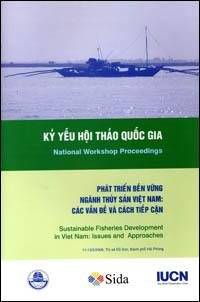

Related content
Unselective, unsustainable, and unmonitored trawl fisheries?
In 2016, the term UUU (unselective, unsustainable and unmonitored) fishing was developed and a Resolution of the World Conservation Congress, adopted by Members, tasked IUCN’s Species Survival Commission with reporting on the concept. The resulting situation analysis utilises the trawl fisheries of China, Thailand and Vietnam to explore how some of the issues associated with UUU fishing can be linked back to these three elements. The report found considerable variation in each component of UUU across the case study countries but that uncontrolled fishery development resulting in excess fishing capacity is commonly a root cause, leaving long standing impacts which have proven very challenging to solve. Whilst the report does not provide recommendations for action, it does identify 14 areas where further work would help accelerate progress on sustainable use, the protection of species of conservation concern and help safeguard the marine ecosystem.
State of West African marine protected areas 2022
The coastal zone of West Africa extends approx. 6,000 km, from Mauritania in the north, passing through the deeply indented coasts of the islands and estuaries, then the lagoon coasts and the coastal strips of the Gulf of Guinea, up to Nigeria. The small island state of the Cabo Verde Islands, volcanic and mountainous, completes this geography. These coastal areas are characterized by globally significant biodiversity. But the marine ecosystem and coastal communities face many challenges, namely illegal, unreported and/or unregulated fishing, pollution, uncontrolled coastal development, etc., which harm habitats and species. This report takes stock of the situation, while offering in-depth analyses as well as recommendations on the opportunities and challenges in terms of marine protected areas in the region.
État des aires marines protégées d’Afrique de l’Ouest 2022
La zone côtière de l’Afrique de l’Ouest s’étend sur environ 6 000 km, depuis la Mauritanie au nord, en passant par les côtes rofondément découpées des îles et des estuaires, puis les côtes lagunaires et les cordons littoraux du Golfe de Guinée, jusqu’au Nigéria. Le petit État insulaire des îles du Cabo Verde, volcanique et montagneux, complète cette géographie. Ces zones côtières sont caractérisées par une biodiversité d’importance mondiale. Mais l’écosystème marin et les communautés côtières sont confrontés à de nombreux défis : pêche illégale, non déclarée et/ou non réglementée, pollution, développement côtier incontrôlé, etc., qui portent atteinte aux habitats et aux espèces. Cette publication fait un état des lieux, tout en proposant des analyses approfondies ainsi que des recommandations sur les opportunités et défis en matière d’aires marines protégées dans la région.
Using the IUCN red list criteria at the national level : a regional consultative workshop for South and Southeast Asia… : proceedings and recommendations
A regional workshop was held to develop a shared understanding of the IUCN global Red List criteria, threat categories and the process of listing species according to the threat of extinction with an emphasis on lessons learned, key constraints and priority needs. The report presents country status reports from Cambodia, India, Indonesia, Lao PDR, Malaysia, Nepal, Pakistan, Philippines, Sri Lanka, Thailand and Vietnam, plus conclusions and recommendations.
Raíz y vuelo : el uso sostenible de los recursos naturales vivientes en Mesoamérica
Proposes an overview of the concept of sustainable use, drawing from the growing body of literature concerned with common property resources, ecosystem management and community based natural resource management. It also provides a synoptic account of the state of living natural resources in Mesoamerica, taking into account the efforts undertaken in situ and ex situ Conservation. It also addresses many of the drivers that are affecting the management and final use of natural resources, with particular emphasis on traditional knowledge systems and community based natural resource management. A final section analyses the range of on-going experiences in the local se and management of natural resources, including forest resources, non timber forest products, wildlife and coastal and marine resources. It is hoped that this state of the art review will serve as a reference for future conservation and sustainable use efforts in the Mesoamerican region.
Rehabilitation of degraded forest ecosystems in Cambodia, Lao PDR, Thailand and Vietnam
Of significant concern to governments in Southeast Asia is the rapid and extensive deforestation and forest degradation that has occurred in the recent past and in some cases is still occurring. The purpose of this publication is to assist stakeholders in the lower Mekong countries develop and implement ecologically and socio-economically sound forest rehabilitation policies and practices. An overview and broad assessment of relevant forest policy and practices are presented, and it is hoped that discussion will be encouraged among key decision-makers about the preferred principles and criteria for guiding future forest rehabilitation programmes.

